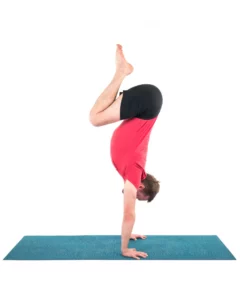Two Keys to Mastering Warrior III (Virabhadrasana lll)

Warrior III is a beautiful standing balance pose that challenges yoga students of all levels. Like all challenging poses, there are a few important tips that, when incorporated into your practice, can make this pose feel a little more accessible. Once again, one of the keys to finding a safe and stable expression of this pose is to engage the core muscles and keep the pelvis stable so you support your lower back. Here are two key ways to master Warrior lll.
The fundamentals of the pose are to stand on one foot and extend the other leg straight out behind you while bringing the torso parallel to the floor. Already this is pretty tough – it requires strength in the quadriceps and quite a bit of flexibility in the hamstrings to extend the lifted leg straight out. And as if that wasn’t tricky enough, in one expression of the pose you also extend your arms out in front of you.
Whether coming up into this pose from Warrior I or coming down into it from standing, I usually like to approach Warrior III in two phases: getting the standing balance and then extending the arms
Two key misalignments in warrior iii
Since this is a challenging pose, it can take a long time to find a steady, comfortable expression. After all, they aren’t called Warrior Poses for nothing! But no matter where you are with this pose, when coming into the standing balance, here are two “don’ts” to watch out for:
Don’t Let Your Raised Hip “Float” Up in Warrior III

Since this is an asymmetrical pose, it’s almost instinctual for the hip on the raised leg to “float” open a bit. This is also an “escape valve” if your hamstrings are tight.
When the hip lifts into external rotation, the pelvis (and, therefore, the torso) twists, the standing thigh internally rotates, and this puts more pressure on the knee (and to some extent the ankle), which is supporting the whole weight of the body.
Putting too much strain on the stabilizing ligaments of the knee is a bad idea, and can lead to injury.
How to Keep Your Hips Level in Warrior III

- Lower the raised hip down by flexing the ankle and pointing the toes toward the floor (which internally rotates the thigh).
- Strongly press through the lifted heel.
- Engage the standing quadriceps and add some external rotation to counteract the body’s tendency to let the thigh – and, therefore, the knee – work inward.You might feel an increased hamstring stretch as you do this but will also have more stability as you bring your pelvis back in line. Remember you always have the option to bend your standing leg.
Don’t Let Your Low Back Arch

With the combined motion of extending the arms and the back leg, it’s easy to give in to gravity and let the front of the body pull downward, increasing the arch in the lower back. Furthermore, we usually tend to crane our necks to look forward and up in this pose, which exaggerates the arch even more.
How to Practice Yoga’s Warrior III (Virabhadrasana III)

- Keep your tailbone lifting as you lift your belly button strongly upward.
- Bring your neck in line with your spine.
- Imagine extending between the heel of your raised foot and the crown of your head so your spine lengthens and the arch in your back is minimized.
A strong core is, eventually, what you will need to hold your arms out in front of you as well. Remember that your lower back is naturally curved, so we are not trying to eliminate its curvature – just to make sure that we are not putting too much strain on it.
Those are the two key ways to master Warrior lll.
Beginner Yoga Modifications for Warrior III

- Practice Warrior III with your hands on a chair (pictured above)
- Do the pose with your hands in prayer, hands stretched out behind you, or with your arms entwined (it makes for a nice transition to Eagle Pose!)
- Do the pose with your palms pressing into a wall
- Do the pose with your back heel pressing into a wall
- If your hamstrings are tight, allow your knees to bend while keeping the rest of the alignment of the pose.



